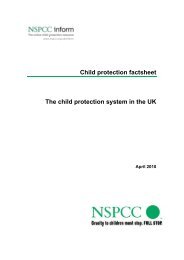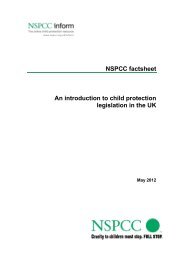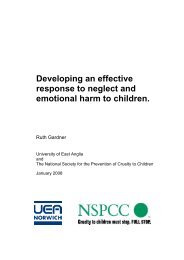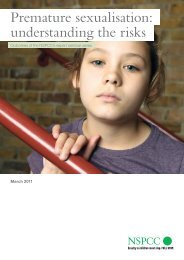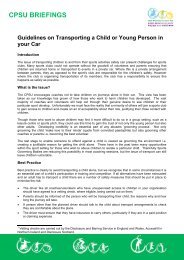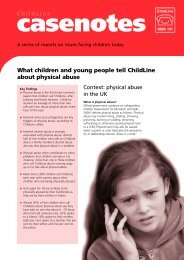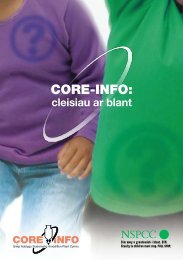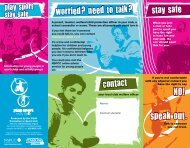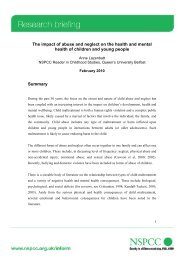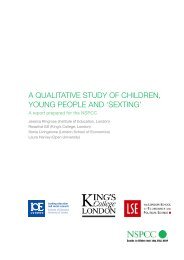Neglect and serious case reviews (PDF, 735KB) - nspcc
Neglect and serious case reviews (PDF, 735KB) - nspcc
Neglect and serious case reviews (PDF, 735KB) - nspcc
Create successful ePaper yourself
Turn your PDF publications into a flip-book with our unique Google optimized e-Paper software.
2. <strong>Neglect</strong> in the lives of children who become the subject of a <strong>serious</strong> <strong>case</strong> review – a statistical overview<br />
2.3 the exteNt of <strong>Neglect</strong> aS a feature of the caSe<br />
(N=83 from 139 caSeS from 2009–11)<br />
Although a CP plan for neglect denotes that there is <strong>serious</strong> neglect, it does not imply that<br />
children without such a plan are not experiencing neglect, <strong>and</strong> that in some circumstances<br />
it might be severe. Indeed the finding that none of the six children who died of extreme<br />
deprivation (starvation) had a CP plan in any category serves to reinforce this suggestion.<br />
Since one of our research questions seeks to discover how often neglect is evident in<br />
the families of children who become the subject of a <strong>serious</strong> <strong>case</strong> review, it is important<br />
to consider indications of neglect for all children at the centre of a review including<br />
those who had never had a plan in place. This includes children in need of services (s17<br />
Children Act 1989) <strong>and</strong> children who were not getting any help from children’s social<br />
care <strong>and</strong> were in receipt of lower level specialist services or only universal services.<br />
For this part of the analysis we are using information from <strong>serious</strong> <strong>case</strong> <strong>reviews</strong> from<br />
2009–11. We have restricted the analysis to the <strong>case</strong>s from this two year period because<br />
this offers us the fullest information from the six years of analysis, as well as being the<br />
most current available. This material was coded in SPSS <strong>and</strong> anonymised as part of<br />
the 2012 Department for Education funded study (Br<strong>and</strong>on et al 2012). Drawing from<br />
information from overview reports <strong>and</strong> executive summaries for 139 of the 184 <strong>serious</strong><br />
<strong>case</strong> <strong>reviews</strong> from 2009–11, we were able to identify whether neglect was present, using<br />
a specifically developed protocol of indicators. This protocol includes indicators such as<br />
a child protection plan for neglect, but widens to incorporate other indications of neglect<br />
drawn from the information available on the <strong>case</strong>s (see overleaf).<br />
Identifying neglect through this protocol was sometimes constrained by the varying form<br />
<strong>and</strong> detail of information available to us, <strong>and</strong> inherent difficulties surrounding precise<br />
definitions of neglect. While some of the information sources did mention what may<br />
be considered risk factors for neglect (for example parental substance misuse, mental<br />
health problems, domestic abuse etc.) we did not use this information alone to indicate<br />
the presence of neglect. These constraints should be borne in mind when interpreting<br />
the results. This analysis is also contained in the research team’s recent biennial report<br />
on <strong>serious</strong> <strong>case</strong> <strong>reviews</strong> (Br<strong>and</strong>on et al 2012).<br />
33




